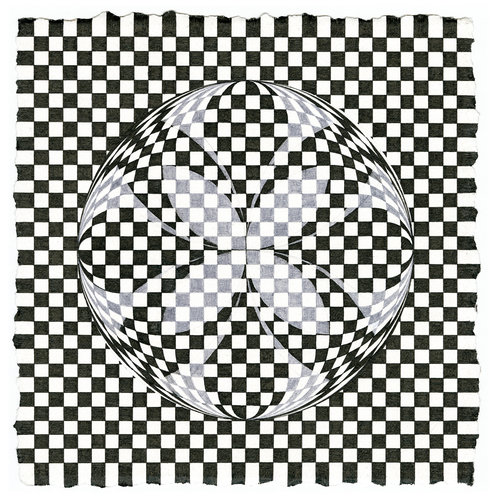Return to Image Gallery

“The Universe is not only stranger than we imagine—it is stranger than we can imagine.”
This idea, attributed to multiple sources in the scientific world including J.B, Haldane and William Eddington among others, points to how little we humans actually understand the circumstances we find ourselves in.
The shadow you see out of the corner of your eye that is gone when you turn to look, the images that race from memory on waking from a dream, the certainty that you have experienced something before or the notion that something is somehow different than you recall, all speak to our uneasiness. There is a deep feeling that there is something more than we perceive with our senses, that the universe is an intricately woven affair, full of energy, portals, emptiness, matter, unseen dimensions, and entanglements which don’t follow expected paths, and speak to something just beyond consciousness. This is Ghost Bird.
While it is difficult to envision multi-dimensional space, the geometry in these pieces attempts to elucidate these hidden spatial and temporal aspects of reality. The trees ground us in what is more easily discernible in our environment and speak to the interwoven nature of life. They bear witness to our time here.
We have a need to find patterns to organize the entropy of life and the fabric of our reality. We make up systems that support our personal desires and service the needs of the societies we create based on what we think we know of our world from observation, circumstance and custom. Some of us make up stories to fill in the blanks, and choose to believe them; some imagine possibilities that inform their daily practices in metaphorical ways, and others postulate theories and attempt to prove them by physical means and thought experiments. All of these practices stem from a desire to understand and capture a fleeting glimpse of what we cannot quite see. We want to believe there is an underlying framework informing our existence. A logic for life and death. Mythology, magic, religion and science all do this.
For me, the crow encapsulates this idea. Depending on the mythology, the crow is believed to be a bad omen or harbinger of good fortune. Crows might appear to warn of death, or foretell a new beginning. They speak of transformation, and are thought to bring messages from the spirit world. They are studied by the scientific community and considered a symbol of intelligence and wisdom by many for their abilities to problem-solve, and make and use tools. Like humans, crows remember. Perhaps they tell their own stories. These are some of mine.

“The Universe is not only stranger than we imagine—it is stranger than we can imagine.”
This idea, attributed to multiple sources in the scientific world including J.B, Haldane and William Eddington among others, points to how little we humans actually understand the circumstances we find ourselves in.
The shadow you see out of the corner of your eye that is gone when you turn to look, the images that race from memory on waking from a dream, the certainty that you have experienced something before or the notion that something is somehow different than you recall, all speak to our uneasiness. There is a deep feeling that there is something more than we perceive with our senses, that the universe is an intricately woven affair, full of energy, portals, emptiness, matter, unseen dimensions, and entanglements which don’t follow expected paths, and speak to something just beyond consciousness. This is Ghost Bird.
While it is difficult to envision multi-dimensional space, the geometry in these pieces attempts to elucidate these hidden spatial and temporal aspects of reality. The trees ground us in what is more easily discernible in our environment and speak to the interwoven nature of life. They bear witness to our time here.
We have a need to find patterns to organize the entropy of life and the fabric of our reality. We make up systems that support our personal desires and service the needs of the societies we create based on what we think we know of our world from observation, circumstance and custom. Some of us make up stories to fill in the blanks, and choose to believe them; some imagine possibilities that inform their daily practices in metaphorical ways, and others postulate theories and attempt to prove them by physical means and thought experiments. All of these practices stem from a desire to understand and capture a fleeting glimpse of what we cannot quite see. We want to believe there is an underlying framework informing our existence. A logic for life and death. Mythology, magic, religion and science all do this.
For me, the crow encapsulates this idea. Depending on the mythology, the crow is believed to be a bad omen or harbinger of good fortune. Crows might appear to warn of death, or foretell a new beginning. They speak of transformation, and are thought to bring messages from the spirit world. They are studied by the scientific community and considered a symbol of intelligence and wisdom by many for their abilities to problem-solve, and make and use tools. Like humans, crows remember. Perhaps they tell their own stories. These are some of mine.
